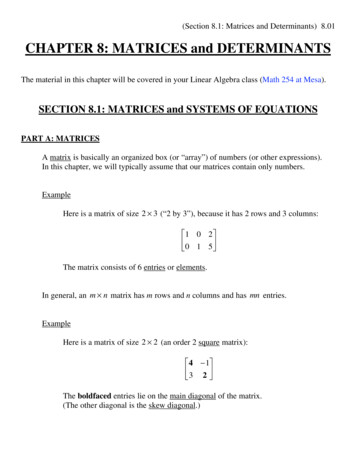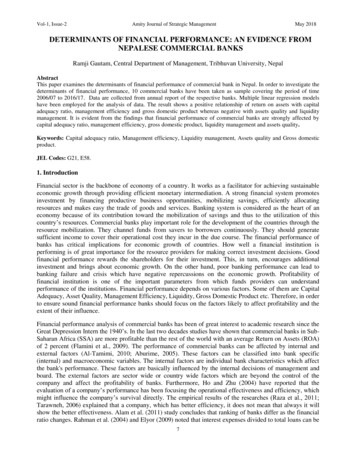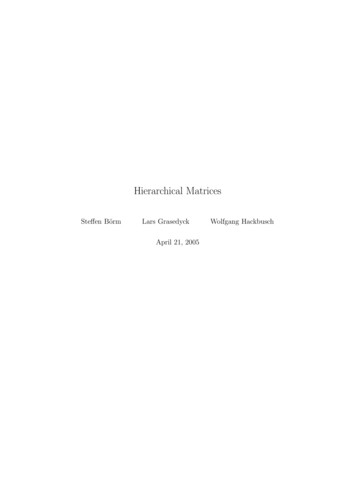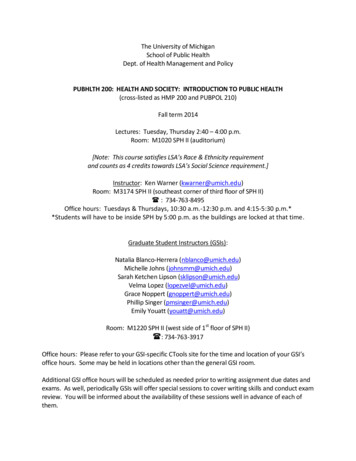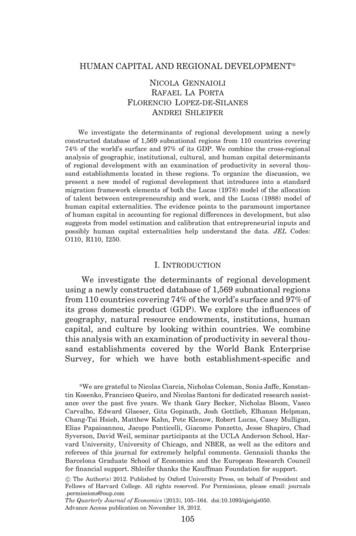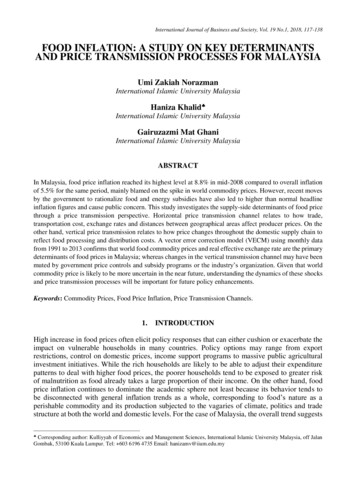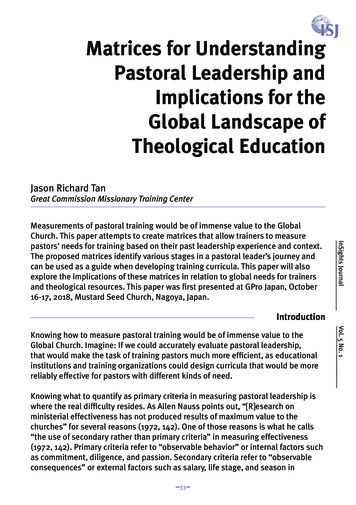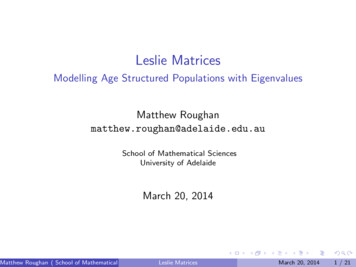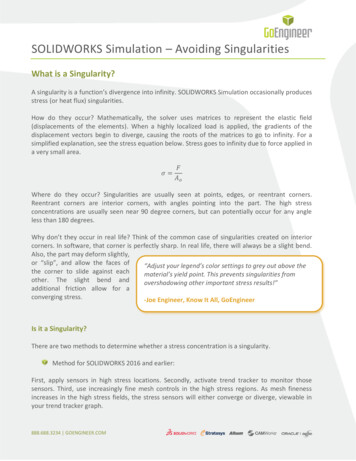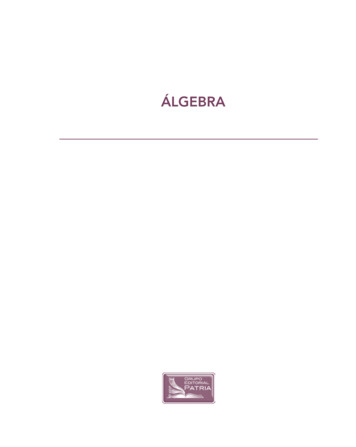
Transcription
Chapter 9222Matrices and DeterminantsChapter 9Matrices and Determinants9.1Introduction:In many economic analysis, variables are assumed to be related bysets of linear equations. Matrix algebra provides a clear and concisenotation for the formulation and solution of such problems, many of whichwould be complicated in conventional algebraic notation. The concept ofdeterminant and is based on that of matrix. Hence we shall first explain amatrix.9.2Matrix:A set of mn numbers (real or complex), arranged in a rectangularformation (array or table) having m rows and n columns and enclosed by asquare bracket [ ] is called m n matrix (read “m by n matrix”) .An m n matrix is expressed asa12 a1n a11 aa22 a2n 21A am1am2 amn The letters aij stand for real numbers. Note that aij is the element inthe ith row and jth column of the matrix .Thus the matrix A is sometimesdenoted by simplified form as (aij) or by {aij} i.e., A (aij)Matrices are usually denoted by capital letters A, B, C etc and itselements by small letters a, b, c etc.Order of a Matrix:The order or dimension of a matrix is the ordered pair having asfirst component the number of rows and as second component the numberof columns in the matrix. If there are 3 rows and 2 columns in a matrix,then its order is written as (3, 2) or (3 x 2) read as three by two. In generalif m are rows and n are columns of a matrix, then its order is (m x n).Examples:
Chapter 9 1 2 3 4 5 6 , 223 a1 a 2 1 2 and b1 b 2 c1 c 2 3 d1 d 2Matrices and Determinantsa3b3c3d3a4 b 4 c4 d4 are matrices of orders (2 x 3), (3 x 1) and (4 x 4) respectively.9.3 Some types of matrices:1.Row Matrix and Column Matrix:A matrix consisting of a single row is called a row matrix or arow vector, whereas a matrix having single column is called a columnmatrix or a column vector.2.Null or Zero Matrix:A matrix in which each element is „0‟ is called a Null or Zeromatrix. Zero matrices are generally denoted by the symbol O. Thisdistinguishes zero matrix from the real number 0. 0 0 0 0 For example O is a zero matrix of order 2 x 4. 0 0 0 0 The matrix Omxn has the property that for every matrix Amxn,A O O A A3.Square matrix:A matrix A having same numbers of rows and columns is called asquare matrix. A matrix A of order m x n can be written as Amxn. Ifm n, then the matrix is said to be a square matrix. A squarematrix of order n x n, is simply written as An.Thusandare square matrix oforder 2 and 3Main or Principal (leading)Diagonal:The principal diagonal of a square matrix is the ordered set ofelements aij, where i j, extending from the upper left-hand corner to thelower right-hand corner of the matrix. Thus, the principal diagonalcontains elements a11, a22, a33 etc.For example, the principal diagonal of
Chapter 9224Matrices and Determinants 1 3 1 5 2 3 6 4 0 consists of elements 1, 2 and 0, in that order.Particular cases of a square matrix:(a)Diagonal matrix:A square matrix in which all elements are zero except those in themain or principal diagonal is called a diagonal matrix. Some elements ofthe principal diagonal may be zero but not all.For example 1 0 0 4 0 0 2 and 0 1 0 0 0 0 are diagonal matrices.In generala12 a11 aa 22 21A a n1a n2 a1n a 2n (a ij )nxn a nn is a diagonal matrix if and only ifaij 0for i jaij 0for at least one i j(b) Scalar Matrix:A diagonal matrix in which all the diagonal elements are same, iscalled a scalar matrix i.e.Thusand k 0 0 0 k 0 0 0 k are scalar matrices(c) Identity Matrix or Unit matrix:A scalar matrix in which each diagonal element is 1(unity) iscalled a unit matrix. An identity matrix of order n is denoted by In.
Chapter 9225 1 0 Thus I2 0 1 Matrices and Determinantsand 1 0 0 I3 0 1 0 0 0 1 are the identity matrices of order 2 and 3 .In general,a12 a1n a11 aa22 a2n 21A [aij]mxn am1am2 amn is an identity matrix if and only ifaij 0 for i j and aij 1for i jNote: If a matrix A and identity matrix I are comformable formultiplication, then I has the property thatAI IA A i.e., I is the identity matrix for multiplication.4.Equal Matrices:Two matrices A and B are said to be equal if and only if they havethe same order and each element of matrix A is equal to the correspondingelement of matrix B i.e for each i, j, aij bijThusthenA andB A B because the order of matrices A and B is sameand aij bij for every i , j.Example 1: Find the values of x , y , z and a which satisfy thematrix equation Solution :From (1)By the definition of equality of matrices, we havex 3 0 .(1)2y x -7 (2)z – 1 3 (3)4a – 6 2a (4)x -3
Chapter 9226Matrices and DeterminantsPut the value of x in (2) , we get y -2From (3)z 4From (4)a 35.The Negative of a Matrix:The negative of the matrix Amxn, denoted by –Amxn, is the matrixformed by replacing each element in the matrix Amxn with its additiveinverse. For example, 3 -1 A3x2 2 -2 -4 5 3 1 A3x2 2 2 4 5 IfThenfor every matrix Amxn, the matrix –Amxn has the property thatA (–A) (–A) A 0i.e., (–A) is the additive inverse of A.The sum Bm-n (–Amxn) is called the difference of Bmxn and Amxnand is denoted by Bmxn – Amxn.9.4 Operations on matrices:(a) Multiplication of a Matrix by a Scalar:If A is a matrix and k is a scalar (constant), then kA is a matrixwhose elements are the elements of A , each multiplied by k 4 3 For example, if A 8 2 then for a scalar k, 1 0 kA
Chapter 9227Matrices and Determinants 5 8 4 15 24 12 3 0 3 5 09 15 3 1 4 9 3 12 Also,(b)Addition and subtraction of Matrices:If A and B are two matrices of same order m n then their sumA B is defined as C, m n matrix such that each element of C is the sumof the corresponding elements of A and B .for exampleIfThenandB C A B Similarly, the difference A – B of the two matrices A and B is a matrixeach element of which is obtained by subtracting the elements of B fromthe corresponding elements of AThus ifthen,A A - B B If A, B and C are the matrices of the same order mxnthenA B B Aand(A B) C A (B C) i.e., the addition of matrices iscommutative and Associative respectively.Note: The sum or difference of two matrices of different order is notdefined.(c)Product of Matrices:Two matrices A and B are said to be conformable for the productAB if the number of columns of A is equal to the number of rows of B.Then the product matrix AB has the same number of rows as A and thesame number of columns as B.Thus the product of the matrices Amxp and Bpxn is the matrix(AB)mxn. The elements of AB are determined as follows:
Chapter 9by228Matrices and DeterminantsThe element Cij in the ith row and jth column of (AB)mxn is foundcij ai1b1j ai2b2j ai3b3j . ainbnjfor example, consider the matrices a11 a12 a 21 a 22 A2x2 and b11 b12 b 21 b22 B2x2 Since the number of columns of A is equal to the number of rows of B,the product AB is defined and is given as a11b11 a12 b21 a11b12 a12 b22 a 21b11 a 22 b21 a 21b12 a 22 b22 AB Thus c11 is obtained by multiplying the elements of the first rowof A i.e., a11 , a12 by the corresponding elements of the first column of Bi.e., b11 , b21 and adding the product.Similarly , c12 is obtained by multiplying the elements of the firstrow of A i.e., a11 , a12 by the corresponding elements of the secondcolumn of B i.e., b12 , b22 and adding the product. Similarly for c21 , c22 .Note :1 . Multiplication of matrices is not commutative i.e., AB BA ingeneral.2 . For matrices A and B if AB BA then A and B commute toeach other3 . A matrix A can be multiplied by itself if and only if it is a squarematrix.The product A.A in such cases is written as A2.Similarly we may define higher powers of a square matrix i.e.,A . A2 A3 , A2. A2 A44. In the product AB, A is said to be pre multiple of B and B is saidto be post multiple of A.Example 1: 12 2 1 12 2 1 2 2If A and B 1 1 Find AB and BA. 1 3 Solution:1 2 AB 1 3 1 1 2 3 1 3 4 3 2 1
Chapter 9229 2 1 1Matrices and Determinants2 2 1 4 3 2 3 BA 1 3 1 111 1 7 0 5 This example shows very clearly that multiplication of matrices ingeneral, is not commutative i.e., AB BA.Example 2: IfExample 2: 3 1 2 If A and B 1 0 1 1 1 2 1 , find AB 3 1 Solution:Since A is a (2 x 3) matrix and B is a (3 x 2) matrix, they areconformable for multiplication. We have 1 1 3 1 2 3 2 6 3 1 2 AB 21 1 0 3 1 0 1 1 0 1 3 1 11 0 4 0 Remark:If A, B and C are the matrices of order (m x p), (p x q) and (q x n)respectively, theni. (AB)C A(BC) i.e., Associative law holds.ii.C(A B) CA CB}i.e distributive laws holds.and (A B)C AC BCNote: that if a matrix A and identity matrix I are conformable formultiplication, then I has the property thatAI IA A i.e, I is the identity matrix for multiplication.Exercise 9.1Q.No. 1 Write the following matrices in tabular form:i. A [aij], where i 1, 2, 3 and j 1, 2, 3, 4ii. B [bij], where i 1 and j 1, 2, 3, 4iii. C [cjk], where j 1, 2, 3 and k 1
Chapter 9230Matrices and DeterminantsQ.No.2 Write each sum as a single matrix:i.ii.iii.iv.v.Q.3 2 1 4 6 3 0 3 -1 0 -2 1 0 1 3 5 6 0 -2 1 3 4 6 3 0 1 2 2 3 4 0 0 0 1 6 2 0 0 0 1 0 3 0 0 0 6 1 4 2 2 0 3 3 0 1 1 2 5 1 b11 a11 b12 a12 is a solution of the matrix b 21 a 21 b 22 a 22 Show that b11 b12 a11 a12 and B . b 21 b 22 a 21 a 22 equation X A B, where A Q.4Solve each of the following matrix equations:i.X 2ii.iii.iv. 3 1 5 1 2 3 1 1 0 2 6 4 8 X 1 5 2 0 02 1 0 2 2 3 1 3X 2 1 3 1 2 0 4 1 5 0 1 5 3 1 2 X 2I 1
Chapter 9Q.5i.ii.iii.iv.231Matrices and DeterminantsWrite each product as a single matrix: 1 1 3 1 1 0 1 2 0 2 1 0 1 [3 - 2 2] 2 2 2 1 1 1 1 1 2 1 11 2 10 1 1 2 5 2 1 3 1 2 4 1 3 2 ,C 0 Q.7 1 0 2 0 2 , find A BC. 1 2 1 0 Show that if A and B , then01 12 (a)(A B)(A B) A2 2AB B2(b)(A B)(A – B) A2 – B2Q.8Show that:Q.6 1 4 2 5 1 3 2 4 2 1 1 2 0 1 If A ,B 4 2 1 (i)Q.9 1 2 2 1 3 5 cos θ 0 sin θ3 a a 2b 3c 0 b 2a b 1 c 3a 5b c 0 sin θ cos θ(ii)10 00 cos θ sin θ 2 2 2 2If A and B 2 2 2Show that A and B commute.0 sin θ 1 0 0 10 0 1 0 0 cos θ 0 0 1 2 2 2
Chapter 9232Matrices and DeterminantsAnswers iii) 8 4 4 1 0 0 10 3 3 0 4 0 9 13 7 2 2 5 1 1 11 3 1 1 1 4 2 0 3 3 2 1 2 2 1 0 0 0 1 0 0 0 1 (ii) 11 6 9 (iv) 2 3 4 1 6 2 1 0 3 (ii) 1 2 1 3 (iv) 1 1 1 0 (ii) 1 (iv) 1 0 0 0 1 0 0 0 1
Chapter 9Matrices and Determinants 6 17 8 9 Q.69.5233Determinants:The Determinant of a Matrix:The determinant of a matrix is a scalar (number), obtained from theelements of a matrix by specified, operations, which is characteristic of thematrix. The determinants are defined only for square matrices. It isdenoted by det A or A for a square matrix A.The determinant of the (2 x 2) matrix a11 a12 a 21 a 22 A is given by det A A a11 a12a 21 a 22 a11 a22 – a12 a21Example 3: 31 If A find A 2 3 Solution: A 3 1 9 – (–2) 9 2 11 2 3The determinant of the (3 x 3) matrix a11 a12A a 21 a 22 a 31 a 32a13 a11 a12 a 23 , denoted by A a 21 a 22a 33 a 31 a 32a13a 23a 33is given as, det A A a11a 22a 32a 23a 21 a 23a 21 a 22– a12 a13a 33a 31 a 33a 31 a 32 a11(a22a33 – a23a32) – a12(a21a33 – a23a31) a13(a21a32 – a22a31)Note: Each determinant in the sum (In the R.H.S) is the determinant of asubmatrix of A obtained by deleting a particular row and column of A.
Chapter 9234Matrices and DeterminantsThese determinants are called minors. We take the sign or , accordingto ( 1)i j aijWhere i and j represent row and column.9.6Minor and Cofactor of Element:The minor Mij of the element aij in a given determinant is thedeterminant of order (n – 1 x n – 1) obtained by deleting the ith row andjth column of Anxn.For example in the determinanta11 a12 A a 21 a 22a 31 a 32a13a 23 (1)a 33a 22 a 23The minor of the element a11 is M11 a 32 a 33The minor of the element a12 is M12 a 21 a 23a 31 a 33The minor of the element a13 is M13 a 21 a 22and so on.a 31 a 32The scalars Cij (-1)i j Mij are called the cofactor of the element aijof the matrix A.Note: The value of the determinant in equation (1) can also be found byits minor elements or cofactors, asa11M11 – a12M12 a13M13Ora11C11 a12C12 a13C13Hence the det A is the sum of the elements of any row or columnmultiplied by their corresponding cofactors.The value of the determinant can be found by expanding it fromany row or column. 3 2 1 Example 4: If A 0 1 2 1 3 4 find det A by expansion about (a) the first row (b) the first column.Solution (a) A 3 2 1 0 1 21 3 4
Chapter 9235 3(b)Matrices and Determinants1 20 20 1–2 13 41 41 3 A 3(4 6) – 2(0 2) 1 (0 – 1) 30 – 4 – 1 25 A 31 22 10 1–0 13 43 41 3 3 (4 6) 1 (–4 –1) 30 – 5 A 259.7Properties of the Determinant:The following properties of determinants are frequently useful intheir evaluation:1. Interchanging the corresponding rows and columns of adeterminant does not change its value (i.e., A A‟ ). Forexample, consider a determinant A a1 a2a3b1b2b3c1c2 c3(1) a1(b2c3 – b3c2) – b1(a2c3 – a3c2) c1(a2b3 – a3b2) . (2)Now again consider B a1 a 2 b1 b 2c1 c2a3b3c3Expand it by first column B a1(b2c3 – b3c2) – b1(a2c3 – a3c2) c1(a2b3 – a3b2)which is same as equation (2)soa1 B a 2a3b1b2b3c1c2c3or B A 2. If two rows or two columns of a determinant are interchanged, thesign of the determinant is changed but its absolute value isunchanged.For example if
Chapter 9236 A a1a2a3Matrices and Determinantsb1b2b3c1c2c3b2b1b3c2c1c3Consider the determinant, B a2a1a3expand by second row, B –a1(b2c3 – b3c2) b1(a2c3 – a3c2) – c1(a2b3 – a3b2) –(a1(b2c3 – b3c2) – b1(a2c3 – a3c2) c1(a2b3 – a3b2))The term in the bracket is same as the equation (2)So B a1– a2a3b1b2b3c1c2c3Or B – A 3. If every element of a row or column of a determinant is zero, thevalue of the determinant is zero. For example A 0a2a30b2b30c2c3 0(b2c3 – b3c2) –0(a2c3 – a3c2) 0(a2b3 – a3b3) A 04. If two rows or columns of a determinant are identical, the value ofthe determinant is zero. For example, if A a1a1a3b1 c1b1 c1b 3 c3 a1(b1c3 – b3c1) – b1(a1c3 – a3c1) c1(a1b3 – a3b1) a1b1c3 – a1b3c1 – a1b1c3 a3b1c1 a1b3c1 – a3b1c1 A 05. If every element of a row or column of a determinant is multipliedby the same constant K, the value of the determinant is multipliedby that constant. For example if,
Chapter 9237 A Matrices and Determinantsa1a2a3b1b2b3c1c2c3ka1 kb1 kc1Consider a determinant, B a 2b2 c2a 3 b 3 c3 B ka1(b2c3 – b3c3) – kb1(a2c3 – a3c2) kc1(a2b3 – a3b2) k(a1(b2c3 – b3c3) – b1(a2c3 – a3c2) c1(a2b3 – a3b2))So B a1 k a2a3b1b2b3c1c2c3Or B K A 6. The value of a determinant is not changed if each element of anyrow or of any column is added to (or subtracted from) a constantmultiple of the corresponding element of another row or column.For example, if A a1a2a3b1b2b3c1c2c3Consider a matrix, B a1 ka 2a2a3b1 kb2b2b3c1 kc2c2c3 (a1 ka2)(b2c3–b3c2)–(b1 kb2)(a2c3–a3c2) (c1 kc2)(a2b3–a3b2) [a1(b2c3 – b3c2) –b1(a2c3 – a3c2) c1(a2b3 – a3b2)] [ka2(b2c3 – b3c2) –kb2(a2c3 – a3c2) kc2(a2b3 – a3b2)]a1 a2a3b1b2b3c1a2c2 k a 2c3a3b2b2b3c2c2c3
Chapter 9a1 a2a3238b1b2b3Matrices and Determinantsc1c2 k(0) because row 1st and 2nd are identicalc3 B A 7. The determinant of a diagonal matrix is equal to the product of itsdiagonal elements. For example, if A 2 0 0 0 5 00 0 3 2(–15 – 0) – (0 – 0) 0(0 – 0) 30, which is the product of diagonal elements.i.e., 2(–5)3 –308. The determinant of the product of two matrices is equal to theproduct of the determinants of the two matrices, that is AB A B . for example, ifA Then AB AB a11 a12,a 21 a 22B b11 b12b 21 b 22a11b11 a12b 21 a11b12 a12b 22a 21b11 a 22b 21 a 21b12 a 22b 22 (a11b11 a12b21)(a21b12 a22b22)- (a11b12 a12b22 – a11b22)(a21b11 a22b21) a11b11 a21b12 a11b11 a22b22 a12b21a21b12 a12b21 a22b22 - a11b12 a21b11 - a11b12 a22b21- a12b22 a21b11 - a12b22 a22b21 AB a11b11 a22b22 a12b21 a21b12 - a11b12 a22b21- a12b22 a21b11 . (A)and A a11a22 - a12a21 B b11b22 - b12b21 A B a11b11 a22 b22 a12b21 a21 b12 - a11b12 a22 b21- a12b22 a21 b11 . (B)R.H.S of equations (A) and (B) are equal, so AB A B 9. The determinant in which each element in any row, or column,consists of two terms, then the determinant can be expressed as thesum of two other determinants
Chapter 9239a1 1a 2 2a 3 3b1b2b3c1a1c2 a 2c3a3Matrices and Determinantsc1 1c2 2c3 3b1b2b3b1b2b3c1c2c3Expand by first column.Proof:L.H.S (a1 1)(b2c3–b3c2)–(a2 2)(b1c3–b3c1) (a3 3)(b1c2 – b2c1) [(a1(b2c3–b3c2)–a2(b1c3–b3c1) a3(b1c2 – b2c1)] [( 1(b2c3–b3c2)– 2(b1c2–b3c1) 3(b1c2 – b2c1)]a1 a2a3b1b2b3c1 1c2 2c3 3b1 c1b2 c2b3 c3 R.H.SSimilarly 1 a1 b1 β1 c1a1 2 a 2 b2 β 2 c2 a 2 3 a 3 b 3 β 3 c3a3 1 2 3a1 1And,a 2 2a 3 3a1 a2a3b1b2b3b1b2b3c1a1 β1c2 a 2 β 2c3a 3 β3c1c2c3b1b2b3c1 1 β1c2 2 β2c3 3 β3c1c2c3b1 β1b2 β2b3 β 3c1 1c2 2c3 3c1 1 β1 1c2 sum of six determinant 2 β 2 2c3 3 β3 3a1 1 b1 β1 c1 1a1Also a 2b2c2 a 2a3b3c3a3b1b2b3c1 1 β1 1c2 a 2 β2 2c3 a 3 β 3 3
Chapter 9240Matrices and Determinants21 a bc 1 a aExample 5: Verify that 1 b ca 1 b b 21 c ab 1 c c 2Solution:Multiply row first, second and third by a, b and c respectively, inthe L.H.S., thena2aabc1b b2L.H.S abcc c2abcabcTake abc common from 3rd columna2 1a abcb b2 1abcc c2 1Interchange column first and third1 a2a 1 b2b1 c2cAgain interchange column second and third1 aa2 1 bb21 cc2 R.H.SExample 6: Show that1 aa21 b b 2 (b – c) (c – a) (a – b)1 cc2
Chapter 9241Matrices and DeterminantsSolution:a21 a1 b b2L.H.S 1 cc2subtracting row first from second and third row1a2a0 b a b2 a 2 0 c ac2 a 2from row second and third taking (b – a) and (c – a) common.1 a a2 (b – a)(c – a) 0 1 b a0 1 c aexpand from first column (b – a)(c – a)(c a – b – a) (b – a)(c – a)(c – b)Or L.H.S (b – c)(c – a)(a – b)(–1)(–1) (b – c)(c – a)(a – b) R.H.SExample 7: Without expansion, show that6 23 41060311224 028Solution:In the L.H.S Taking 2 common from fourth row, so6 2L.H.S 23 2106031112424Since rows 2nd and 3rd are identical, so 2(0) 0L.H.S R.H.S
Chapter 99.8242Matrices and DeterminantsSolution of Linear Equations by Determinants:(Cramer’s Rule)Consider a system of linear equations in two variables x and y,a1x b1y c1(1)a2x b2y c2(2)Multiply equation (1) by b2 and equation (2) by b1 and subtracting,we getx(a1b2 – a2b1) b2c1 – b1c2x b2c1 b1c2a1b2 a 2b1(3)Again multiply eq. (1) by a2 and eq. (2) by a1 and subtracting, wegety(a2b1 – a1b2) a2c1 – a1c2a 2c1 a1c2a 2b1 a1b2a c a 2c1y 1 2a1b2 a 2b1y (4)Note that x and y from equations (3) and (4) has the samedenominator a1b2 – a2b1. So the system of equations (1) and (2) hassolution only when a1b2 – a2b1 0.The solutions for x and y of the system of equations (1) and (2) canbe written directly in terms of determinants without any algebraicoperations, asc1cx 2a1a2b1b2and y b1b2a1 c1a 2 c2a1 b1a 2 b2This result is called Cramer‟s Rule.Herea1a2b1 A is the determinant of the coefficient of x and yb2in equations (1) and (2)Ifc1c2b1 A b2
Chapter 9and243a1a2Then x Matrices and Determinantsc1 A c2AxAand y AyASolution for a system of Linear Equations in Three Variables:Consider the linear equations:a1x b1y c1z d1a2x b2y c2z d2a3x b3y c3z d3Hence the determinant of coefficients isa1 A a 2a3b1b2b3c1c2 , if A 0c3Then by Cramer‟s Rule the value of variables is:x y andExample 8:Solution:z 3a1a2a3 AxAAyAAzAUse Cramer‟s rule to solve the system– 4x 2y – 9z 23x 4y z 5x – 3y 2z 8
Chapter 9244Matrices and DeterminantsHere the determinant of the coefficients is: A 4 2 9 34 11 3 2 –4(8 3) – 2(6 – 1) – 9(– 9 – 4) – 44 – 10 117 A 63for Ax , replacing the first column of A with the correspondingconstants 2, 5 and 8, we have Ax 2 2 9 5 418 3 2 2(11) – 2(2) – 9(- 47) 22 – 4 423 Ax 441Similarly, Ay 4 2 9 3 5 11 8 2 – 4 (2) – 2(5) – 9(19) – 8 – 10 – 171 Ay –189and Az 4 2 2 34 51 3 8 –4(47) – 2(19) 2(–13) – 188 – 38 – 26 Az – 252
Chapter 9Hence245x y z Matrices and DeterminantsA x 441 763AAyA 189 –363A z -252 –463ASo the solution set of the system is {(7, –3, –4)}Exercise 9.2Q.1Q.2Expand the determinants(i)1 2 03 -1 4-2 1 3(iii)x 0 00 x 00 0 x(ii)a b 1a b 11 1 1Without expansion, verify that(i)-2 1 03 4 1 0-4 2 0(iii)a-b b-c c-ab-c c-a a-b 0 (iv)c-a a-b b-c(v)x 1 x 2 x 3x 4 x 5 x 6 0x 7 x 8 x 9(ii)1 2 11 2 10 2 3 0 2 32 -1 20 -5 0bc ca aba31ab31bc3 01c
Chapter 9(vi)Q.3246a b ce b hd e f d a gg h kf c kShow thata1a2b1b2c1x d1 c2 x d 2Q.4Q.5Q.6Matrices and Determinantsa3a1 a 2 x b1 b2b3c3x d3c1 c2a3a1 a 2b3 b1 b2c3d1 d 2a3b3d3Show that(i)0 a b a 0 c 0 b c 0abca a ba b c a 3a 2a b 3a 2b c(iii)a-b-c 2a2a2b b-c-a 2b (a b c)32c2c c-a-b(iv)111bc caab (b c)(c a)(a b)b c c a a b(ii)Show that:(i)a aaa (2a )( a) 2a a(ii)a aaaa aaaa 2(3a )prove that:(i) a b c 3 abc333
Chapter 9247Matrices and Determinants2 λ (a b c λ)(ii)(iii)Q.7Sin Sin Cos Cos Cos Sin Find values of xif(i)Q.80Sin Sin ( )Cos (ii)0Use Cramer‟s rule to solve the following system of equations.(i)x–y 2(ii)3x – 4y –2x 4y 5x y 6(iii)x – 2y z –1(iv)2x 2y z 13x y – 2z 4x – y 6z 21y–z 13x 2y – z –4(v)x y z 0(vi)x – 2y – 2z 32x – y – 4z 152x – 4y 4z 1x – 2y – z 73x – 3y – 3z 4Answers 9.2x3Q.1(i) –41Q.7(i) x -2 , 3Q.8(i) 13 3 , 5 5 (ii) 22 20 , 7 7 (iii){(1, 1, 0)}(iv){(1, –2, 3)}(v){(3, –1, –2)(vi)(ii)0(ii)(iii)x 3,4
Chapter 99.9248Matrices and DeterminantsSpecial Matrices:1. Transpose of a MatrixIf A [aij] is mxn matrix, then the matrix of order n x m obtainedby interchanging the rows and columns of A is called the transpose of A.It is denoted At or A . 1 2 3 Example if A 4 5 6 , 7 8 9 then 1 4 7 At 2 5 8 3 6 9 2.Symmetric Matrix:A square matrix A is called symmetric if A Atfor example if a b c A b d e , c e f then a b c A b d e A c e f tThus A is symmetric3. Skew Symmetric:A square matrix A is called skew symmetric if A Atfor example ifB Bt ,then ( 1)Bt BThus matrix B is skew symmetric.4.Singular and Non-singular Matrices:A square matrix A is called singular if A 0 and is non-singularif A 0, for example if 3 2 , then A 0, Hence A is singular6 A 9
Chapter 9249Matrices and Determinants 3 1 6 and if A 1 3 2 , then A 0, 1 0 0 Hence A is non-singular.Example:Solution:Find kIfA is singular1 k-2Since A is singular so 5k 2 0(k – 2)( k 2) – 5 0k2 – 4 – 5 0k2 – 9 0 K 35. Adjoint of a Matrix:Let A (aij) be a square matrix of order n x n and (cij) is a matrixobtained by replacing each element aij by its corresponding cofactor cijthen (cij)t is called the adjoint of A. It is written as adj. A.For example , if 1 0 1 A 1 3 1 0 1 2 Cofactor of A are:A11 5,A12 - 2,A21 -1,A22 2,A31 3,A32 -2,Matrix of cofactors isCCt 5 1 3 5 2 1 2 1 2 1 2 3 1 3 2 2 1 3 A13 1A23 -1A33 3
Chapter 9250Hence adj A CMatrices and Determinants 5 1 3 2 2 2 1 1 3 tNote: Adjoint of a 2 2 Matrix:The adjoint of matrixA is denoted by adjA is defined asadjA 6. Inverse of a Matrix:If A is a non-singular square matrix , then 3A 1For example if matrix 2Then adj A -1A-1 adj A A 4 2 -4 3 6–4 2 A HenceA-1 adj A1 2 A 2 -1-4 3 Alternately:For a non singular matrix A of order (n x n) if there exist anothermatrix B of order (n x n) Such that their product is the identity matrix I oforder (n x n) i.e., AB BA IThen B is said to be the inverse (or reciprocal) of A and is writtenas B A-1Example 9: 1 3 1 3 7 7 3 If A and B 2 1 then show that 27 AB BA I and therefore, B A-1Solution:AB 2 7 3 1 0 2 1 0 1
Chapter 9251Matrices and Determinants 7 3 1BA 2 1 2Hence AB BA Iandand 3 1 0 7 0 1 7 3 therefore B A-1 2 1 Example 10: Find the inverse, if it exists, of the matrix. 0 -2 -3 A 1 3 3 -1 -2 -2 Solution: A 0 2 (–2 3) – 3(–2 3) 2 – 3 A –1, Hence solution exists.Cofactor of A are:A11 0,A12 1,A13 1A21 2,A22 –3,A23 2A31 3,A32 –3,A33 2Matrix of transpose of the cofactors is 0 2 3 adj A C -1 -3 -3 1 2 2 So 01 1A adj A -1 1 A 1 0-1A 1 -1–12 3 -3 -3 2 2 -2 -3 3 3 -2 -2
Chapter 99.11252Matrices and DeterminantsSolution of Linear Equations by Matrices:Consider the linear system:a11x1 a12x2 ------ a1nxn b1a21x1 a22x2 ------ a2nxn b2 .(1)an1x1 an2x2 ------ annxn bnIt can be written as the matrix equationLet a11 a12 ------ a1n x1 b1 a a ------ a x b 2n 2 21 22 2 a n1 a n2 ------ a nn x n b n a11 a12 ------ a1n x1 a a ------ a x 21 222n , X 2 A a n1 a n2 ------ a nn x n b1 b 2B bn Then latter equation can be written as,AX BIf B 0, then (1) is called non-homogenous system of linearequations and if B 0, it is called a system of homogenous linearequations.If now B 0 and A is non-singular then A-1 exists.Multiply both sides of AX B on the left by A-1, we getA-1 (AX) A-1B(A-1 A)X A-1 B1X A-1 BOrX A-1 BWhere A-1 B is an n x 1 column matrix. Since X and A-1 B areequal, each element in X is equal to the corresponding element in A-1 B.These elements of X constitute the solution of the given linear equations.
Chapter 9253Matrices and DeterminantsIf A is a singular matrix, then of course it has no inverse, and eitherthe system has no solution or the solution is not unique.Example 11: Use matrices to find the solution set ofx y – 2z 33x – y z 53x 3y – 6z 9Solution:Let 1 1 2 A 3 1 1 3 3 6 Since A 3 21 – 24 0Hence the solution of the given linear equations does not exists.Example 12: Use matrices to find the solution set of4x 8y z –62x – 3y 2z 0x 7y – 3z –8Solution: 4 8 1 2 3 2 1 7 3 LetASinceSo A –32 48 17 61A-1 exists.A-11adj A A 5 31 19 1 8 13 16 61 17 20 28 Now since,X A-1 B, we have x 5 31 19 1 y 8 13 16 61 z 17 20 28 6 0 8
Chapter 9254Matrices and Determinants 30 152 2 1 48 48 0 61 102 224 2 Hence Solution set: {(x, y, z)} {(–2, 0, 2)}Exercise 9.3Q.1Which of the following matrices are singular or non-singular.(i)Q.2 1 1 2 (iii) 3 1 1 3 3 6 2 6 7 6 2 3 (ii) 7 3 0 0 3 5 a b c 3 0 6 (iii) b d e 5 6 0 c e f Find K such that the following matrices are singular(i)Q.4 1 2 1 3 4 5 4 2 6 Which of the following matrices are symmetric and skewsymmetric(i)Q.3 1 2 1 3 1 2 (ii) 0 1 1 K 64 3(ii)1 2 -1-3 4 K-4 2 6(iii)Find the inverse if it exists, of the following matrices(i) 1 3 2 -1 (ii)(iii) 1 2 3 -1 0 4 0 2 2 (iv) 0 1 -1 1 -3 -4-2 -3 3 3 -2 -2 2 -1 4 5 2 6 1 1 -23 -1 1k 3 -6
Chapter 9255Matrices and DeterminantsQ.5Find the solution set of the following system by means of matrices:(i)2x – 3y –1 (ii)x 4y 5(iv)–4x 2y – 9z 23x 4y z 5x – 3y 2z (iii)(i)SymmetricSymmetric8(ii)Skew-symmetricx y 2(iii) x – 2y z –12x – z 13x y – 2z 42y – 3z –1y–z 1(v)x y – 2z 33x – y z 03x 3y – 6z 8Answers 9.3Q.3 1 7Q.4 (i) 2 7Q.5(iv)(i)(iv)3 7 1 7 (ii)(ii)A-1 does not exist.{(1, 1)}(ii){(7, -3, -4)} (v)5(iii) 4 5 1(iii) 5 1 5{(1, 1, 1)}no solution(iii)3151 515 4 5 7 10 1 5 {(1, 1, 0)}
Chapter 91.2.3.4.5.256Matrices and DeterminantsSummaryIf A [aij], A [bij] of order m x n. Then A B [aij bij] is alsom x n order.The product AB of two matrices A and B is conformable formultiplication if No of columns in A No. of rows in B.If A [aij] is m x n matrix, then the n x m matrix obtained byinterchanging the rows and columns of A is called the transpose ofA. It is denoted by At.Symmetric Matrix:A square matrix A is symmetric if At A. a11 a12 a13 If A a 21 a 22 a 23 Then, a 31 a 32 a 33 c11 c21 c31 (i)adj A c12 c22 c32 , aij are the co-factor elements. c13 c23 c33 And inverse of A is:adj A A (ii)A-1 6.A square matrix A is singular if A 0.
Chapter 9257Matrices and DeterminantsShort Question
Matrices are usually denoted by capital letters A, B, C etc and its elements by small letters a, b, c etc. Order of a Matrix: The order or dimension of a matrix is the ordered pair having as first compon
